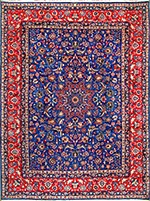Textiles Studies

Textile Research Works
Date of this Version
1996
Document Type
Article
Citation
7. Internationale Konferenz für Orientteppiche Vorträge. Hamburg 17.-20.6.93 Berlin 20.-22.6.9 (1996)
Abstract
Among Persian pile-weavings, the most famous are carpets produced in Safavid Iran connected with the Persian monarchy or with European royalty. These include the Habsburg hunting Carpet today in the Osterreichisches Museum for Anfewandte Kunst, Vienna, the Swedish royal carpet, and perhaps the Boston Hunting Carpet . A hunting carpet which may also be categorized as a "medallion carpet" is that in Milan at the Poldi Pezzoli; another celebrated medallion carpet is the Ardabil carpet in the Victoria & Albert Museum, London , with a companion in the Los Angeles County Museum of Art. More numerous are the star medallion carpets generally considered to be from northwestern Iran, probably from the turn of the 17th century. Also more numerous, but more problematic in their attribution, are the so-called Herat carpets that are sometimes referred to as Inda-Persian carpets for a lack of clear definition of their origins. Surviving in larger quantity with firmer grounds for attribution are the so-called Polonaise carpets from Kashan and Isfahan in the first half of the 17th century. Of these, perhaps now the most famous is that referred to as the Coronation Carpet presented to the wife of a Danish king in 1665 and used since in several anointment ceremonies and stored with the Danish regalia (throne, lions, orb and scepter) at Rosenborg Castle, Copenhagen (Rosenborg). 10 Less well-known pile-weavings of Safavid Iran are Persian velvets of the 17th century. These velvets are scattered in various museums and private collections, usually singly or in small undistinguished groups. Also fairly neglected in the literature, such Persian velvets were both better known and better appreciated at the Mughal court in India, and at royal and ducal courts of 17th century Europe than they are perhaps today.
Included in
Art and Materials Conservation Commons, Art Practice Commons, Fiber, Textile, and Weaving Arts Commons, Indigenous Studies Commons, Museum Studies Commons

